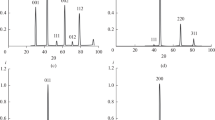Conclusions
Low-temperature coreduction of tungsten trioxide and ammonium perrhenate can be employed as a means of preparing active tungsten-rhenium powders having well-developed surfaces and good sinterability. The action of an alloy formation activator manifests itself most strongly with active powders produced by the method of low-temperature coreduction of tungsten trioxide and ammonium perrhenate. Diffusional reaction between the tungsten and rhenium in such a case begins already during the reduction process. At temperatures of intense alloy formation phase interlayers of activator solid solutions form at grain boundaries in tungsten-rhenium alloys. As a result, the diffusional permeability of the boundaries to rhenium atoms grows, which activates the process of diffusional alloy formation.
Similar content being viewed by others
Literature cited
V. V. Skorokhod, V. V. Panichkina, and L. I. Shnaiderman, “Effect of palladium on shrinkage and diffusional interaction during the sintering of tungsten and rhenium powders,” Dopovidy Akad. Nauk Ukr. SSR, Ser. A, No. 5, 469–472 (1975).
V. V. Skorokhod, S. M. Solonin, L. I. Chernyshev, L. L. Kolomiets, and L. I. Shnaiderman, “Activating effect of small additions of Group VIII metals on alloy formation during the sintering of tungsten and molybdenum powders mixed with other refractory metals,” Poroshk. Metall., No. 6, 21–25 (1976).
I. V. Uvarova, V. V. Panichkina, and L. D. Konchakovskaya, “Low-temperature reduction of molybdenum and tungsten oxides,” Izv. Akad. Nauk SSSR, Met., No. 4, 86–91 (1972).
V. V. Skorokhod, “Effect of nonequilibrium vacancies on the recovery and deformation kinetics of distorted metal crystals,” Poroshk. Metall., No. 2, 57–62 (1968).
E. M. Savitskii, V. P. Polyakova, and N. A. Tylkina, Palladium Alloys [in Russian], Nauka, Moscow (1967).
Author information
Authors and Affiliations
Additional information
Translated from Poroshkovaya Metallurgiya, No. 1(205), pp. 36–40, January, 1980.
Rights and permissions
About this article
Cite this article
Shnaiderman, L.I., Skorokhod, V.V. Effect of palladium on the process of diffusional alloy formation and microstructure during the sintering of tungsten-rhenium powders with well-developed surfaces. Powder Metall Met Ceram 19, 27–30 (1980). https://doi.org/10.1007/BF00798158
Received:
Issue Date:
DOI: https://doi.org/10.1007/BF00798158




